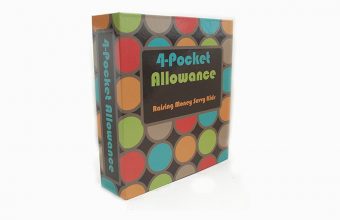We all know that teaching kids about money is important. There are tips and tricks and games you can play to help them understand what money is. But what about teaching them about the value of money and the importance of giving back? It can be a tricky subject to get crystal clear. And even trickier to know at what age you should you start.
Here are some great strategies to help your child understand the value of money, including saving and giving back.
Step 1: Knowing When & How to Save
When teaching kids about money, it’s important for them to understand the association between wanting things and buying them—and how saving money plays a role. And the earlier you start teaching them about it, the better.
When my kids want something and I say we can’t buy it because it’s too much money, they’ll often say “Just go to the bank to get money—they have lots there!” So—yeah… They need a little help understanding why you save and how to do it. Here are a few ways to make saving fun for your kids.
Try an Allowance
Kids can’t really understand money if they don’t have any. Try giving them a certain allowance (you can set the rules and parameters around it) and encourage them to take a portion of it to set aside for saving.
Start Simple with a Piggy Bank
It’s an easy way to show kids first-hand how to save. Tell them that the goal is to fill up the piggy bank with coins and dollars and it’s important to keep it in a safe place so that their money can ‘grow’.
Open Up Their First Bank Account
I still remember going to get my first bank account and keeping track of everything in that little printed booklet. I felt very special and important. (And now I feel like I’m dating myself). Once your kids fill up their piggy bank, show them that this is where they can keep their money and save for a special purchase or occasion.
Step 2: Understanding Money – By Age Range
One of the best ways for teaching kids about money is to play games and do activities together. Get your hands on actual money so they have it right in front of them and can see it and touch it and move it into groups and more. Here are a few things to try by age range.
Ages 3 to 5: Play Store
Set up shop somewhere in your home and let your kids’ imaginations run wild! Just the other day, my kids each set up their own store with things for sale like toys, books, their stuffies, my sunglasses. They gave each item a price and used real coins to buy and sell with. You can also use pretend money or make some yourself. Either way, this helps kids begin to understand what money is and how you use it.
Ages 6 to 8: Set Goals
If your child has birthday or tooth-fairy money coming to them, encourage them to set a money-saving goal they can reach. When my daughters desperately wanted a certain toy, I told them that they had almost enough money from the tooth fairy, but they weren’t quite there. They wanted to see—written down—how much more they would need. So, we drew a picture, kind of like a pie chart. It showed them how much they had already saved and how much more they needed in order to get that toy. When teaching kids about money, show them the actual coins and dollars they need to save to reach their goal and it will seem more real to them.
Ages 9 to 10: Try Out the Real Thing
By now, your kid is old enough to handle real money—and if they’ve had pocket money or an allowance for a few years, chances are they’ll be only too eager to get spending! The next time you clear out your closets, consider hosting a yard sale. Let them take charge of pricing the items ahead of time, so they get a sense of how much an item is worth. You can also make them responsible for collecting money from customers—the slow pace of a yard sale will give them ample opportunity to work out how much change is owed, and they can even try their hand at negotiating and haggling!
Step 3: Introducing the Importance of Giving Back
Once they understand what money is and the benefits of saving, it’s a good time to introduce the concept of giving back. Here are a few key ways for kids to experience all the good that comes out of it.
Sponsor a Child
My kids were astounded when they first learned that not all kids have the advantages they do. They couldn’t fathom a child not having drinking water or not being able to go to school. Sponsoring a child in need through a charitable organization demonstrates how individuals can make changes that matter.
Raise Money for a Cause
Choose something that everyone can do together as a family so you’ll have fun while also giving to an important cause. The Canadian Cancer Society CIBC Run for the Cure is a great way to get the littlest of kids and even grandparents involved.
I’ve personally taken part in this run for several years and I find that it’s not only a great way to raise funds for the Canadian Cancer Society, it’s also inspirational, community-building and an awesome way to demonstrate to kids that the money they raise will go to important breast cancer research. You can explain to them that the money goes to the clever scientists who are trying to find ways to save and cure people like Grandma or (here’s where you can insert the names of any family or friends you know who have been diagnosed with breast cancer).
This year’s CIBC Run for the Cure takes place on Sunday, October 1—and you can find your local run here.
If you’re already feeling inspired, sign up here—or you can even donate to someone already running.
This post is brought to you by the Canadian Cancer Society CIBC Run for the Cure, but the images and opinions are our own.
Tagged under: Money,kids and money,teaching kids about money,giving back,budgets,learning about charity
Category: family-life






